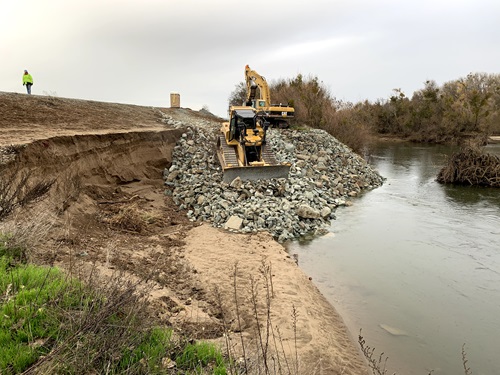Levee Inspections

A DWR levee inspector provides oversight as a contractor repairs erosion on a levee along the Stanislaus River in December 2019.
The Flood Project Inspection and Assessment Section (FPIAS) annually inspects the State-federal portions of the flood management system within California's Central Valley. We develop a summary report documenting the results of these annual levee, channel, and structure inspections, as well as other activities. We also create detailed inspection reports documenting the deficiencies found in each Local Maintaining Agency (LMA), which are used by the LMAs, the U.S. Army Corps of Engineers (USACE), DWR, the Central Valley Flood Protection Board (CVFPB), and other interested parties.
The Flood Project Inspection and Assessment Section (FPIAS) is responsible for developing and administering a program to facilitate LMA reporting requirements. LMAs are required to report specific information to DWR related to the project levees by September 30 of each year. FPIAS consolidates this information and provides it in the annual report that is submitted to the Central Valley Flood Protection Board (CVFPB) by December 31 of each year. The annual report is a summary of inspection results and information collected from LMAs responsible for the operation and maintenance of the 1,600 miles of project levees in the State-federal flood protection system.
To support the collection, compilation, evaluation, and reporting of this information, FPIAS has developed a web-based information management system. The web-based system is used by LMA representatives and staff to develop annual reports. Annual reports can be downloaded from the website.
FPIAS inspectors update and maintain a Levee Log database to document the features and encroachments found within the legal boundary of the State Plan of Flood Control.
FPIAS categorizes these items, documents their location with a global positioning system (GPS), and documents permits or other authorization information that is available. This information and the resulting PDF Levee Logs are beneficial to our partners as they provide a single location to find encroachment information such as:
- Permit numbers for authorized encroachments
- Location of ramps, gates, and turnouts for heavy equipment access
- Locations of utilities and other encroachments that may pose a threat during high water
If you represent an LMA or flood control agency, you can request access to the Levee Log database by emailing leveerepair@water.ca.gov.
Each year FPIAS conducts a Supplemental Waterside Erosion Survey of the San Joaquin River Flood Control System to document and monitor erosion sites. During the survey we:
- Inspect the waterside levee for erosion activity and nearby riverbank for erosion
- Document and report new erosion sites
- Document and report the current condition of previously identified erosion sites
- Rank the severity of erosion sites based upon the findings from the field survey
Levee penetrations are recognized as hazard elements that affect the integrity of State Plan of Flood Control levees. Pipes that are heavily corroded, leaking, collapsed, or otherwise compromised can adversely affect the structural integrity of the levee embankment by creating internal erosion mechanisms. Identifying the precise location of these crossings and documenting their external conditions provides important information for assessing levee vulnerabilities.
To accomplish this task, FPIAS developed and currently manages a system-wide database of pipes and other conduits that cross the 1,600 miles of levees in the State Plan of Flood Control system. FPIAS inspects these pipes on a 5-year cycle, performing external inspections of approximately 20% of the pipes in the system each year. The data collected is used in assessments of LMA maintenance and is shared with the LMAs, the CVFPB, and the USACE.
Among other tasks, FPIAS inspectors also conduct regulatory inspections of construction projects requiring encroachment permits from the CVFPB, assist the CVFPB with enforcement issues, conduct investigations as needed, provide training on flood fight methods, collect and share imagery of levees, assist with post-fire recovery efforts, and perform the duties of flood fight specialists during a flood emergency.
